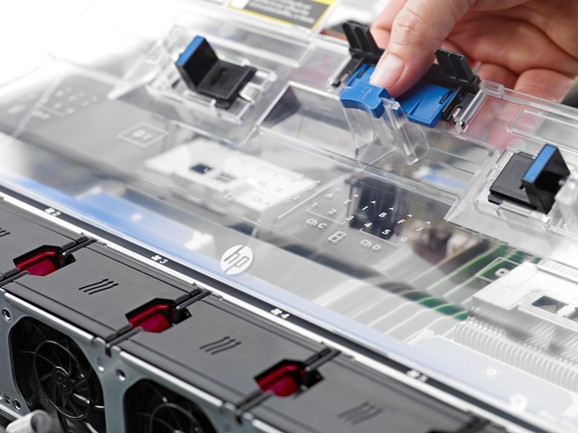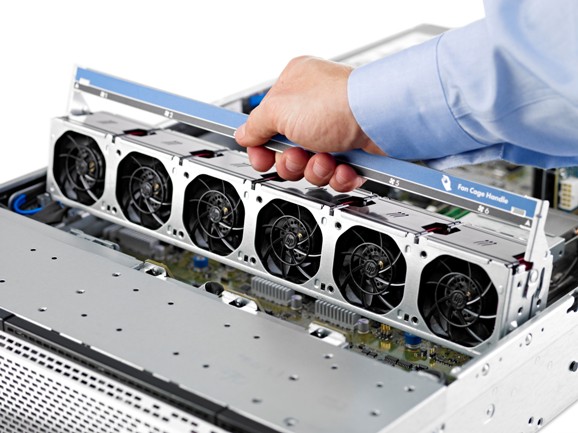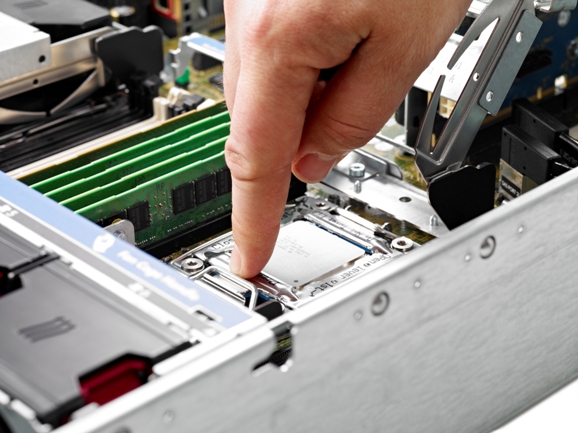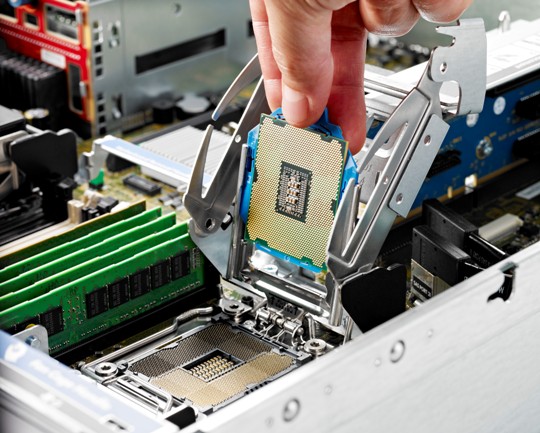HP ProLiant Gen8 - 150 server design enhancements
The development of the eighth generation of HP ProLiant lasted more than two years and, finally, this spring, together with the new eight-core Intel Xeon E5-2600 processor (Sandy Bridge EP), these HP servers are entering the market. Server performance has improved up to 80% compared with HP ProLiant sevenths, the maximum amount of RAM per server has now grown to 768 GB (24 slots), support for PCI Express 3.0 and 10 Gigabit Ethernet is implemented.
However, in the new servers, not only the Intel processor and chipset has changed, but practically the entire hardware platform. HP engineers have implemented fifteen hundred component enhancements to simplify server maintenance, increase their performance and enhance functionality.
For example, consider the dual-propelled HP ProLiant DL380p Gen8 (according to statistics from HP, the largest manufacturer of x86 servers, the DL380 is the best-selling model in the HP ProLiant series, and therefore among all of the standard architecture servers). Now the server, like the other HP ProLiant Gen8 rack and tower models (ML and DL series), is equipped with a keyed security panel with perforation, which closes access to its internal hard drives.
')

In the eighth generation, HP ProLiant uses a completely redesigned, more compact design of the Smart Carrier disc basket and as a result, the HP ProLiant DL380p Gen8 in its maximum configuration holds about twice as many hard drives as a similar seventh-generation model. Currently, models with 16 SFF and 8 LFF disks are available, and in the summer up to 25 small form factor disks or 12 full-size disks per server are expected to be supported.

The Smart Carrier basket is equipped with LED status and drive activity indicators: the round indicator in the center changes color depending on the health of the disk, the green circle shows when the disk is performing read / write operations. In addition, a red Do Not Remove indicator is added to the disc eject button, which lights up when ejecting a disc may result in data loss.

The air duct inside the server has become transparent, which makes it easy to see the memory slots, cables and other server stuffing under it.

Another useful improvement for easier access to the internal components of the server is the ability to remove the entire fan assembly in one motion, for example, to access the backplane of hard drives.

Of course, as in previous generations of HP ProLiant, you can remove a separate fan assembly.

In the new generation, the raiser for PCI Express cards is divided into two parts, i.e. there are two slots for it, so that all expansion cards can be full-sized (full height and full length).

The new server does not have integrated Ethernet ports — they were replaced by FlexLOM network ports, which are a separate fee. Previously, the server owner was limited to the network interface that is already built into the board, now he can choose between Broadcom single or ten Gigabit FlexLOM interface cards from Intel (there will be five options available).
For ease of maintenance (access to memory modules) and improved hot air exhaust, the cable system inside the server is made using flat cables.
To install the processor in HP ProLiant Gen8 uses a special design Smart Socket. Now it is almost impossible to damage the processor or socket during installation. And as statistics of appeals collected by HP service centers shows, bent contacts when installing or replacing a CPU is the most common cause of a motherboard failure. To remove the processor, you only need to open the latch on the spring and then the entire socket can be removed without touching the processor itself. Smart Socket guides ensure accurate installation of a new processor in a free socket




HP ProLiant DL380p also uses new Snap and Go rails and more convenient latches for mounting in a server rack.
Fuhh, it seems nothing is forgotten. If someone was on the presentations of Gen8, then supplement and ask. Let's look at what a miracle is - ProLiant Gen8 - and what is really useful from what is presented, and what is superfluous or incomprehensible.
However, in the new servers, not only the Intel processor and chipset has changed, but practically the entire hardware platform. HP engineers have implemented fifteen hundred component enhancements to simplify server maintenance, increase their performance and enhance functionality.
For example, consider the dual-propelled HP ProLiant DL380p Gen8 (according to statistics from HP, the largest manufacturer of x86 servers, the DL380 is the best-selling model in the HP ProLiant series, and therefore among all of the standard architecture servers). Now the server, like the other HP ProLiant Gen8 rack and tower models (ML and DL series), is equipped with a keyed security panel with perforation, which closes access to its internal hard drives.
')

In the eighth generation, HP ProLiant uses a completely redesigned, more compact design of the Smart Carrier disc basket and as a result, the HP ProLiant DL380p Gen8 in its maximum configuration holds about twice as many hard drives as a similar seventh-generation model. Currently, models with 16 SFF and 8 LFF disks are available, and in the summer up to 25 small form factor disks or 12 full-size disks per server are expected to be supported.

The Smart Carrier basket is equipped with LED status and drive activity indicators: the round indicator in the center changes color depending on the health of the disk, the green circle shows when the disk is performing read / write operations. In addition, a red Do Not Remove indicator is added to the disc eject button, which lights up when ejecting a disc may result in data loss.

The air duct inside the server has become transparent, which makes it easy to see the memory slots, cables and other server stuffing under it.

Another useful improvement for easier access to the internal components of the server is the ability to remove the entire fan assembly in one motion, for example, to access the backplane of hard drives.

Of course, as in previous generations of HP ProLiant, you can remove a separate fan assembly.

In the new generation, the raiser for PCI Express cards is divided into two parts, i.e. there are two slots for it, so that all expansion cards can be full-sized (full height and full length).

The new server does not have integrated Ethernet ports — they were replaced by FlexLOM network ports, which are a separate fee. Previously, the server owner was limited to the network interface that is already built into the board, now he can choose between Broadcom single or ten Gigabit FlexLOM interface cards from Intel (there will be five options available).
For ease of maintenance (access to memory modules) and improved hot air exhaust, the cable system inside the server is made using flat cables.
To install the processor in HP ProLiant Gen8 uses a special design Smart Socket. Now it is almost impossible to damage the processor or socket during installation. And as statistics of appeals collected by HP service centers shows, bent contacts when installing or replacing a CPU is the most common cause of a motherboard failure. To remove the processor, you only need to open the latch on the spring and then the entire socket can be removed without touching the processor itself. Smart Socket guides ensure accurate installation of a new processor in a free socket




HP ProLiant DL380p also uses new Snap and Go rails and more convenient latches for mounting in a server rack.
Fuhh, it seems nothing is forgotten. If someone was on the presentations of Gen8, then supplement and ask. Let's look at what a miracle is - ProLiant Gen8 - and what is really useful from what is presented, and what is superfluous or incomprehensible.
Source: https://habr.com/ru/post/141796/
All Articles